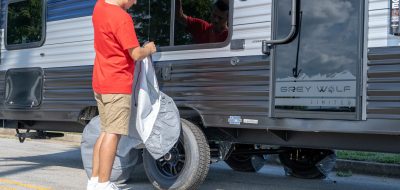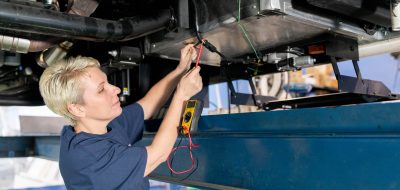
By James Mannett
As soon as someone mentions the word ”Solar” in a crowd of RVers, ears perk up all around. There is a great deal of interest in the use of solar power for RV applications but very few sources of information on the many ways it can be used. Many RVers pride themselves on being handy and are willing to tackle a project like solar. And then there are others that have trouble determining which end is the business end of a screwdriver. No matter which one you are, a little education on solar is usually all that is needed to get you started. And most RV solar companies are happy to help.
First and foremost, it is important to understand that an RV solar system is nothing more than a battery charger. An RV solar system can run anything that runs off your battery pack. Solar is especially useful when boondocking. If you always stay in an RV park with hook ups, and dislike boondocking immensely, don’t waste your money on solar.
There are two ways to think of solar power for an RV. The first is solar trickle charging to maintain a battery’s charge, and the second is RV solar power to produce and store enough power enabling a significant reduction in generator use. Let’s start with the easy one first. Most RV battery systems lose a certain amount of power every day, even when they are not being used. Some types lose more than others. Left for too long, this usually leads to dead batteries when you pick up your rig from storage. If left dead for extended periods, especially during hot weather, permanent battery damage usually occurs. An inexpensive solar trickle charger is all that is needed to prevent this from happening to you and will ensure your batteries are fully charged and ready when you need them.
What is a solar trickle charger? Well, most RV battery systems are 12 volts. (Yes, even you 6 volt battery guys have 12 volt configurations). A 5 watt solar panel, about the size of an iPad, equipped with a length of wire and battery clips, is all you need. In fact, some of you may have noticed that you already have a small solar panel on the roof of your motorhome. That little panel is a solar trickle charger for your engine battery. With panels this small, a charge controller (regulator) is usually not necessary. Connection is a cinch. A good crystalline solar panel will last decades and the cost is usually less than $50.
For you dry camping enthusiasts, full timers, and expert boondockers, simple trickle chargers just won’t do. You can either charge your batteries with a generator, or you can use solar power in a bigger way. I think it’s valuable to mention here that solar panels can’t replace all of your generator use. There are times when Mother Nature just doesn’t provide enough sunshine. Or when the temperatures climb so high that air conditioning is required. At times like these, you will still need to either burn fossil fuels, or just plug in somewhere. The amount of solar power you need (number of panels and type of system) is a function of how you use power.
Many RVers I know are very frugal when it comes to managing their power use. They are conservative with lighting and TV, and they use mostly propane for refrigeration, heat, and cooking. One or two accessory batteries supply all their needs. For these RVers, 60-120 watts of solar is usually all that is necessary. Many of these small systems are now portable. When not in use, the panels fold up and store in a padded bag or case. When setting up camp, the panels are placed on the ground and battery clips are attached to the appropriate battery terminals. A built-in charge controller (regulator) is included and integrated into the panel. These portable solar systems are particularly handy, if your rig is parked under a big shade tree where roof mounted panels are useless. Portable systems are perfect, if poking holes in the roof of your rig makes you queasy. And when trading up, you can take the portable panels with you. A good kit made from crystalline panels will cost from $500-$800. Do your research and ask good questions. While not perfect for every RVer, many find these portable systems to be very useful and give you some green energy bragging rights at the same time.
For those experts and long term boondockers, or those who are planning to be someday, a higher power RV solar system might be necessary. It is not uncommon; especially in the Southwestern desert states during winter, to see motorhomes, trailers and fifth-wheels with two, three, four, or more solar panels on the roof producing 300-800 watts of power. Upon closer examination, a large battery bank and an inverter capable of producing 2000 watts or more of AC power, make up the rest of the RV solar system. These systems capture and store large amounts of solar electricity and then convert it to AC power to run big screen TVs, microwave ovens, electric refrigeration, computers, etc. They provide all of the power necessary for those who have mobile offices, special medical equipment, or simply have too many toys. These systems can cost $5,000 or more and may be a bit too complex for most do-it-yourselfers. But, they enable the occupants to spend many more days each year without hook-ups, saving enough money on park fees to quickly offset the cost in a short period of time.
James Mannett, a former energy industry executive, private consultant, and current owner of CEA Solar www.rvsolarnow.com , writes about solar energy technology and systems for home and RV use. Have questions about RV solar power? You may write James Mannett at [email protected] or visit his blog at http://blog.rvsolarnow.com where you may post your comments or suggestions about this article or others that appear there.
Read more Tech Tips





willin
i suppouse if someone knew absolutely nothing about (photoveitic) solar they might have found some value in this article, but not much. why “Do-It-Yourself” is in the title i do not know.
Jeffrey Wendt
What is the best method to mount a 5w solar panel on a rubber roof?
Thanks
Gale Schmidt
I have one of the Harbor Freight 65 watt unit and have used it on a dry camping trip. I was lucky enough to park next to a Motorola engineer and he had the test equipment to see exactly what the unit would do. If you keep it facing the sun it will produce 2 amps per hour, but its a pain to do this all day. We used it to run a cpap machine which used 32 to amps per night and we could only put back around 20 amps.
So I loose about 10 to 15 amps per day. If you want to dry camp for a extended period of time it would be best to have a 250 watt solar system with at least 4 6 volt deep charge batteries.
Stan Edwards
A good all around book on emergency power that covers solar, wind and fossil generators, batteries, inverters and such is “Emergency Power for Radio Communications” by Bryce published by the American Radio Relay League. Bryce goes into details on sizing systems as well as options in the various categories. It’s application is way beyond just radio communications as he powers his whole house during power outages.
Stan Edwards, WA4DYD
Roadtrek ’06 210-Popular
dan
Any one try the Costco or Harbor Freight solar solution? I have seen 45-60 watt systems in a portable configuration on 5th wheel in South Texas around Corpus Christi, Harbor Freight also has 2000 watt inverters for under 200 bucks. You can make the cheap solar solutions to power lights and maybe a coffee grinder. I think 2 deep cycle batteries are also needed. With our RV we lose power in 3 days off grid from our one battery. We use a honda generator to back it up. I would like to put the 4 15 watt panels up on the roof but don’t want to poke holes in it yet.
Dewey Clay
Very good and correct information is contained in this article. Fifty years of electrical/electronics experience and two years of intense study of things photovoltaic, render me well qualified to make the previous statement. A further caution – the “less than honest” dealers (suppliers and contractors) are already coming out of the woodwork – be careful.